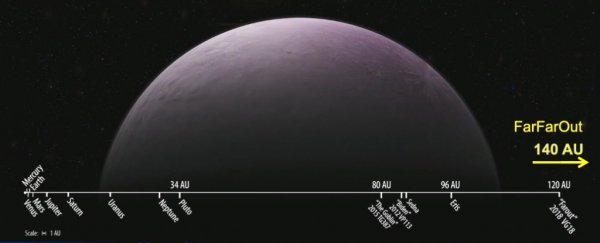At a staggering distance from the Sun, astronomers have just found what they think might be the most distant object ever identified in the Solar System.
They've yet to characterise or define it, but it orbits the Sun at a massive distance of 140 astronomical units (AU), which puts it 3.5 times farther out than Pluto.
Its predecessor, a dwarf planet discovered late last year orbiting at 120 AU, was nicknamed FarOut. So, naturally, the new object is FarFarOut.
The discovery was made by Scott Sheppard of the Carnegie Institution for Science, who is leading the search for the mysterious Planet X. He and his colleagues haven't found the hypothesised giant yet - but they're finding a lot of other things.
There was FarOut. Also last year, they announced the discovery of another dwarf planet, The Goblin, at 65 AU at its perihelion; and 12 previously unseen moons orbiting Jupiter.
Sheppard was scheduled to give a talk about the search on February 20 in Washington DC, but it was postponed due to a snow storm. Rather than sit around twiddling his thumbs, as Science Magazine reported, he got to analysing data.
Then, he spotted something - a tiny object over 20 billion kilometres (12 billion miles) from the Sun. He announced the discovery in his rescheduled talk (you can skip to 39:30 for the relevant part, but the whole talk is great).
"This is hot off the presses," he said.
"Yesterday it snowed, so I had nothing to do, so I went looking through some of our old data… and I actually found this object just last night."
Made a little annotated gif of #Farfarout from the recorded video. pic.twitter.com/YFu8XHEgEm
— Justin Bartel (@cephalopernicus) February 22, 2019
We don't even know much about FarOut yet. Because it's so… far out, its orbit is incredibly large, so it's going to take at least a year or two to understand.
We know even less about FarFarOut, but the team is planning further observation of the mysterious object so we can learn more about it.
Discovering these incredibly distant objects is a really cool achievement in itself, but understanding them is actually helpful in the search for Planet X, thought to be out beyond 200 AU.
As we already saw with The Goblin, since the orbits of these faraway objects can be influenced by the hypothetical planet, they could serve as a signpost to figuring out where it might be.
"These distant objects are like breadcrumbs leading us to Planet X," Sheppard said last year.
"The more of them we can find, the better we can understand the outer Solar System and the possible planet that we think is shaping their orbits - a discovery that would redefine our knowledge of the Solar System's evolution."
Because this discovery is so brand new, it hasn't been confirmed by peer review just yet, and is probably at least a few months from being written up in a paper. But we can't wait to hear what the upcoming observations reveal about the lonely wee thing.
